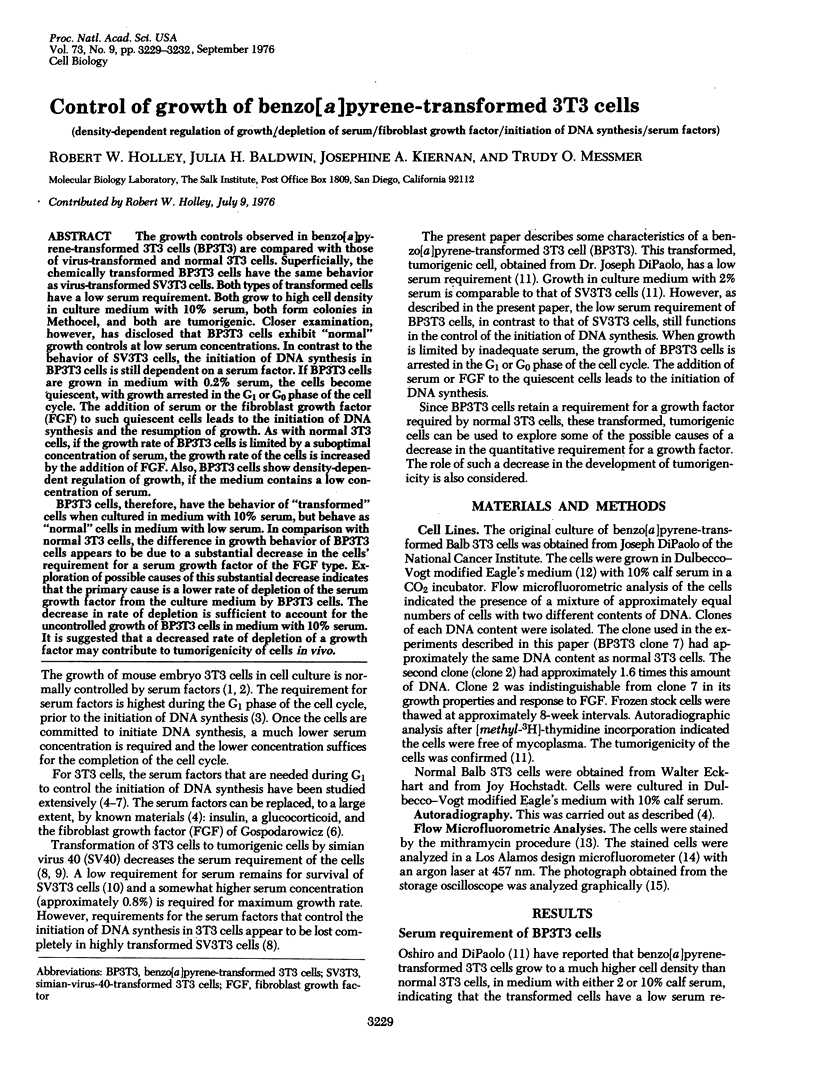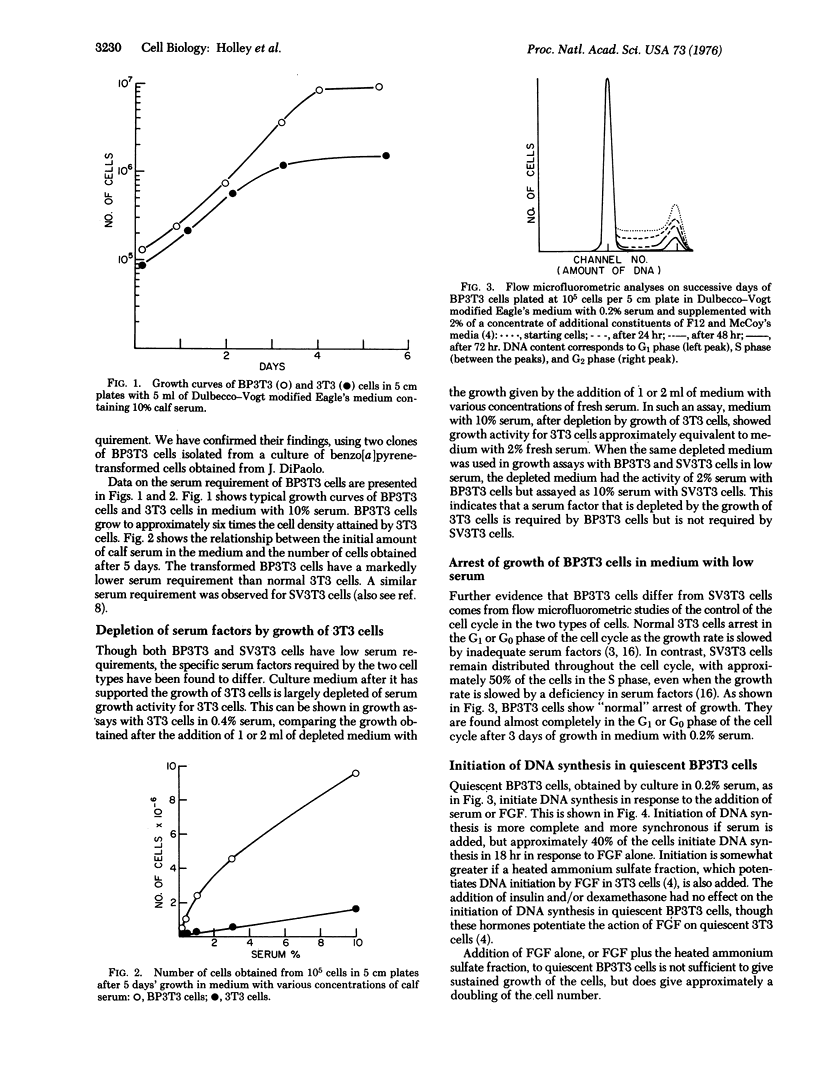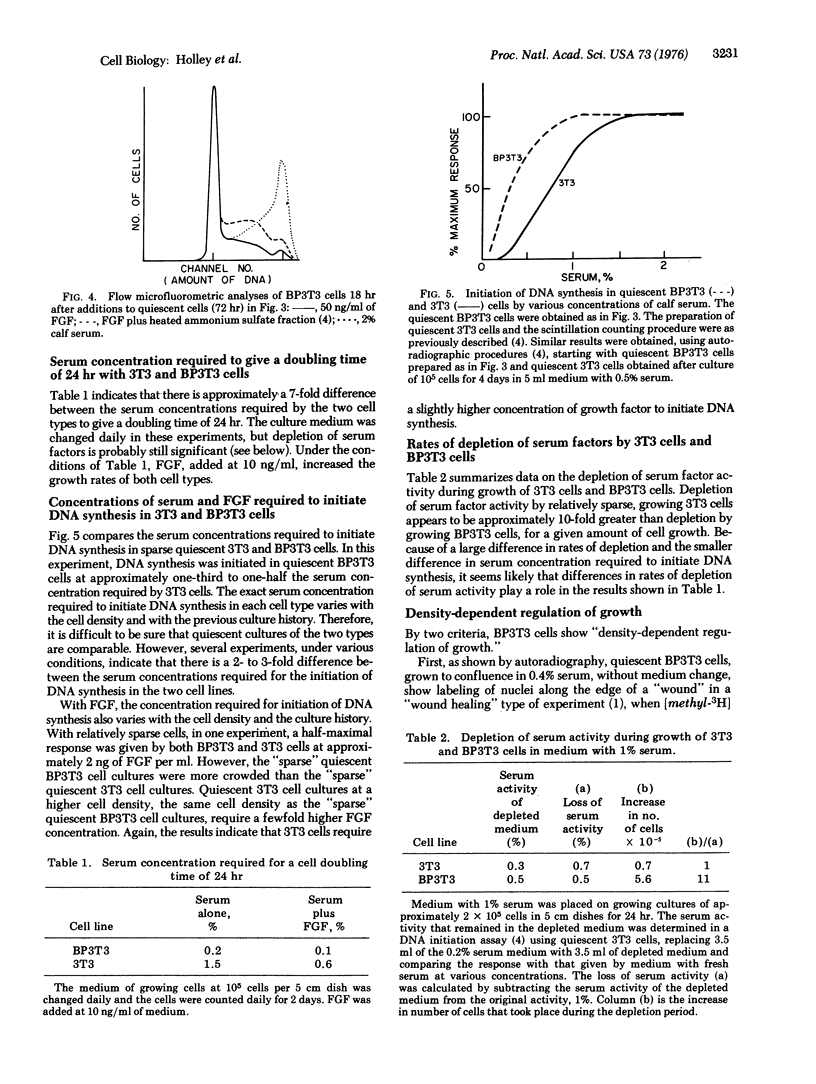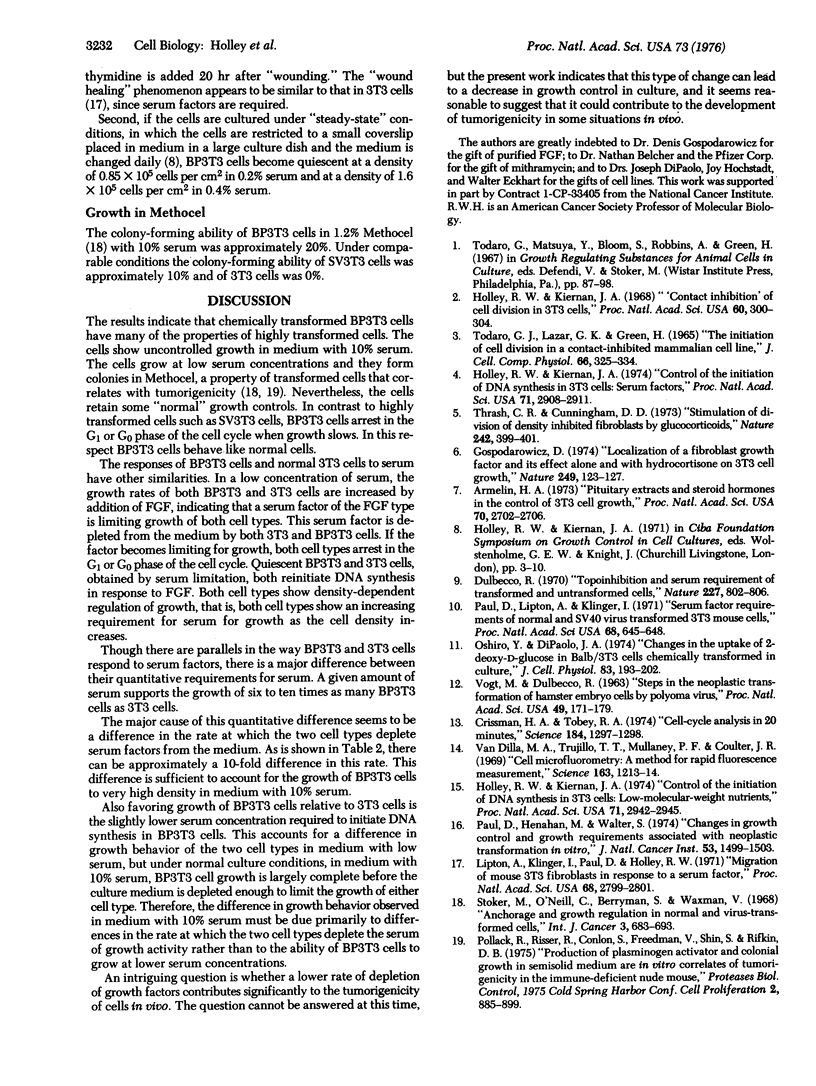Abstract
The growth controls observed in benzo[a]pyrene-transformed 3T3 cells (BP3T3) are compared with those of virus-transformed and normal 3T3 cells. Superficially, the chemically transformed BP3T3 cells have the same behavior as virus-transformed SV3T3 cells. Both grow to high cell density in culture medium with 10% serum, both form colonies in Methocel, and both are tumorigenic. Closer examination, however, has disclosed that BP3T3 cells exhibit "normal" growth controls at low serum concentrations. In contrast to the behavior of SV3T3 cells, the initiation of DNA synthesis in BP3T3 cells is still dependent on a serum factor. If BP3T3 cells are grown in medium with 0.2% serum, the cells become quiescent, with growth arrested in the Gu or G0 phase of the cell cycle. The addition of serum or the fibroblast growth factor (FGF) to such quiescent cells leads to the initiation of DNA synthesis and the resumption of growth. As with normal 3T3 cells, if the growth rate of BP3T3 cells is limited by a suboptimal concentration of serum, the growth rate of the cells is increased by the addition of FGF. Also, BP3T3 cells show density-dependent regulation of growth, if the medium contains a low concentration of serum. BP3T3 cells, therefore, have the behavior of "transformed" cells when cultured in medium with 10% serum, but behave as "normal" cells in medium with low serum. In comparison with normal 3T3 cells, the difference in growth behavior of BP3T3 cells appears to be due to a substantial decrease in the cells' requirement for a serum growth factor of the FGF type. Exploration of possible causes of this substantial decrease indicates that the primary cause is a lower rate of depletion of the serum growth factor from the culture medium by BP3T3 cells. The decrease in rate of depletion is sufficient to account for the uncontrolled growth of BP3T3 cells in medium with 10% serum. It is suggested that a decreased rate of depletion of a growth factor may contribute to tumorigenicity of cells in vivo.
Full text
PDF



Selected References
These references are in PubMed. This may not be the complete list of references from this article.
- Armelin H. A. Pituitary extracts and steroid hormones in the control of 3T3 cell growth. Proc Natl Acad Sci U S A. 1973 Sep;70(9):2702–2706. doi: 10.1073/pnas.70.9.2702. [DOI] [PMC free article] [PubMed] [Google Scholar]
- Crissman H. A., Tobey R. A. Cell-cycle analysis in 20 minutes. Science. 1974 Jun 21;184(4143):1297–1298. doi: 10.1126/science.184.4143.1297. [DOI] [PubMed] [Google Scholar]
- Dulbecco R. Topoinhibition and serum requirement of transformed and untransformed cells. Nature. 1970 Aug 22;227(5260):802–806. doi: 10.1038/227802a0. [DOI] [PubMed] [Google Scholar]
- Gospodarowicz D. Localisation of a fibroblast growth factor and its effect alone and with hydrocortisone on 3T3 cell growth. Nature. 1974 May 10;249(453):123–127. doi: 10.1038/249123a0. [DOI] [PubMed] [Google Scholar]
- Holley R. W., Kiernan J. A. "Contact inhibition" of cell division in 3T3 cells. Proc Natl Acad Sci U S A. 1968 May;60(1):300–304. doi: 10.1073/pnas.60.1.300. [DOI] [PMC free article] [PubMed] [Google Scholar]
- Holley R. W., Kiernan J. A. Control of the initiation of DNA synthesis in 3T3 cells: low-molecular weight nutrients. Proc Natl Acad Sci U S A. 1974 Aug;71(8):2942–2945. doi: 10.1073/pnas.71.8.2942. [DOI] [PMC free article] [PubMed] [Google Scholar]
- Hollwy R. W., Kiernan J. A. Control of the initiation of DNA synthesis in 3T3 cells: serum factors. Proc Natl Acad Sci U S A. 1974 Jul;71(7):2908–2911. doi: 10.1073/pnas.71.7.2908. [DOI] [PMC free article] [PubMed] [Google Scholar]
- Lipton A., Klinger I., Paul D., Holley R. W. Migration of mouse 3T3 fibroblasts in response to a serum factor. Proc Natl Acad Sci U S A. 1971 Nov;68(11):2799–2801. doi: 10.1073/pnas.68.11.2799. [DOI] [PMC free article] [PubMed] [Google Scholar]
- Oshiro Y., DiPaolo J. A. Changes in the uptake of 2-deoxy-D-glucose in BALB-3T3 cells chemically transformed in culture. J Cell Physiol. 1974 Apr;83(2):193–201. doi: 10.1002/jcp.1040830205. [DOI] [PubMed] [Google Scholar]
- Paul D., Henahan M., Walter S. Changes in growth control and growth requirements associated with neoplastic transformation in vitro. J Natl Cancer Inst. 1974 Nov;53(5):1499–1503. doi: 10.1093/jnci/53.5.1499. [DOI] [PubMed] [Google Scholar]
- Paul D., Lipton A., Klinger I. Serum factor requirements of normal and simian virus 40-transformed 3T3 mouse fibroplasts. Proc Natl Acad Sci U S A. 1971 Mar;68(3):645–652. doi: 10.1073/pnas.68.3.645. [DOI] [PMC free article] [PubMed] [Google Scholar]
- Stoker M., O'Neill C., Berryman S., Waxman V. Anchorage and growth regulation in normal and virus-transformed cells. Int J Cancer. 1968 Sep 15;3(5):683–693. doi: 10.1002/ijc.2910030517. [DOI] [PubMed] [Google Scholar]
- Thrash C. R., Cunningham D. D. Stimulation of division of density inhibited fibroblasts by glucocorticoids. Nature. 1973 Apr 6;242(5397):399–401. doi: 10.1038/242399a0. [DOI] [PubMed] [Google Scholar]
- Todaro G. J., Lazar G. K., Green H. The initiation of cell division in a contact-inhibited mammalian cell line. J Cell Physiol. 1965 Dec;66(3):325–333. doi: 10.1002/jcp.1030660310. [DOI] [PubMed] [Google Scholar]
- VOGT M., DULBECCO R. Steps in the neoplastic transformation of hamster embryo cells by polyoma virus. Proc Natl Acad Sci U S A. 1963 Feb 15;49:171–179. doi: 10.1073/pnas.49.2.171. [DOI] [PMC free article] [PubMed] [Google Scholar]
- Van Dilla M. A., Trujillo T. T., Mullaney P. F., Coulter J. R. Cell microfluorometry: a method for rapid fluorescence measurement. Science. 1969 Mar 14;163(3872):1213–1214. doi: 10.1126/science.163.3872.1213. [DOI] [PubMed] [Google Scholar]


